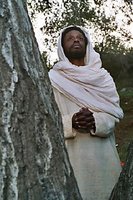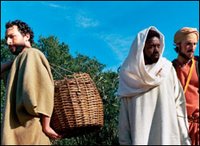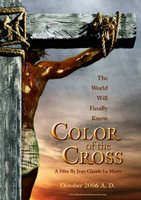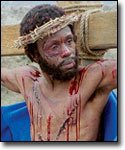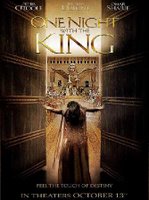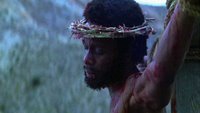
Given the scores of Anglo-Saxons who have played Jesus, it is incredible to think that
Color of the Cross is the first historical film where a black actor has portrayed history's most famous man. Even now, it has taken one man – Jean Claude La Marre – to do a huge amount of the work himself. La Marre wrote, produced and directed the film as well as playing its lead character. The publicity surrounding this film has all been about Jesus's skin color, and La Marre has been fairly vocal about his desire for the film to help the African-American community to see themselves in a new light.
What is unexpected about this film is the way it is also so Jewish. Films about Jesus have largely ignored his Jewish identity. There have, of course, been some token efforts, prayer shawls here, and Aramaic dialogue there, but this film certainly emphasises the Jewishness of Jesus more than any I can recall.
Take, for example, his name. In nearly every other New Testament movie he is called "Jesus" – the Germanised, Latinised version of the Greek translation of his Hebrew name Yeshua (a shortened version of Yehoshua). Here he is called "Yoshua". Other examples include frequent references to the Torah, rabbis and Seders. There are Jewish prayers spoken in Hebrew, and the Romans frequently spit the word "Jew" at those they have dominion over.
When the film comes to the Last Supper, it is placed in context as the footage of Yoshua and his disciples eating is intercut with footage of two other groups also sharing a Passover meal – Yoshua's family, a group of Jewish leaders. In the former, Yoshua's younger brother even asks the question reserved for the youngest person at the table as a way of involving the children in this important celebration. The camera dwells on the bitter herbs and other visual aspects of a traditional Jewish Passover meal.

The film also invests time dwelling on those around the margins of the biblical story. Yoshua's family also heavily features. Joseph is still alive and comforts his wife, teases his daughters and advises his sons, including James who is torn between his responsibilities at home and supporting his brother. Likewise Thaddeus, Philip, Bartholomew, Matthew and Thomas are far more prominent amongst the disciples here than they are in the gospels.
Conversely, the least likeable Jewish characters are Peter and Gamaliel. Gamaliel nails his colours to the mast early on. "I find him to be a very learned man…but he's black, and to say that he is the messiah, it is blasphemy." Peter, on the other hand, is not racist, simply irritating. He is always trying to be the purest and the best of Yoshua's disciples. A (self-appointed?) leader, unaware of the way Yoshua is demonstrating how the first shall be last and the last shall be first. At the same time he is proud, indignant, and arrogant and he is frequently complaining.
The central question of
Color of the Cross is whether one of the main reasons that Jesus was executed was because he was black. This is not simply an incarnational film seeking to reinvent the story of Jesus for a specific people. (If so, all of the Jewish characters would be black. Instead, the other Jewish characters are predominantly played by white actors – wisely the major exception here is Judas). The advance publicity for the film claimed that Jesus really was black, based on the description in
Revelation 1:14-15. Whilst this seems unlikely, the presence of Moses's "Cushite" wife amongst the people of Israel in their early days shows that it may have been at least
possible for other races to have been assimilated into the Jewish people.
Ultimately, the film refuses to answer this crucial question. Early on in the film Mary asks Joseph, "Do you think they doing this to him because he is black?" and the camera zooms in to emphasise the question. But Joseph denies this. "No they're doing this because he's the messiah." Another early scene shows Caiaphas being put under pressure by a Roman official to make sure the peace is kept, and he agrees to hand any troublemakers over if necessary.

Other members of the Sanhedrin seem to be motivated more by the claims of blasphemy. For some, such as Gamaliel, the idea of a black Messiah
is blasphemy. And when members of the Sanhedrin link their judgements to those of the crowd outside – race is clearly one of the issues that motivates them. Yet other Rabbis seem to be against Jesus more on purely religious grounds. Of course Joseph's response could simply be seen as him commenting on the bigger picture. Yoshua is dying because that is what he believes the messiah must do. Perhaps the motivation for Yoshua's death is irrelevant to his father.
The problem with some of this is that it can end up looking like the Jews themselves are racist. The Romans are largely absent in this film, in fact Pilate is neither mentioned nor even seen. Gamaliel's statement that Yoshua needed bringing in to protect him from the crowd implies that Jesus is at risk from a racially motivated lynch mob. Whilst the group of rabbis all take different views, Nicodemus and Joseph of Arimathea are deeply uncertain rather than strictly pro-Yoshua, and their (white) intellectual dithering is too weak-willed to offer any resistance against those who seek to harm him (a possible indictment on equally ambiguous white liberals today). Other members of the Sanhedrin seem to forget their Torah in their desire to see Yoshua crucified.
From a filmmaking point of view the results here are uneven. There are a number of interesting shots, particularly as the film draws to a close. There are also one or two interesting montages, such as the one depicting Yoshua washing his disciples' feet and the one following his death.

Moreover, the film has two particularly masterful moments. Firstly, Yoshua's prayers in Gethsemane are incredibly powerful. With the camera right in his face, LaMarre portrays such fear and desperation that it makes the scene uncomfortable viewing. The shot also evokes images from other films that depict black men awaiting a violent, racially motivated death.
The other is the cut from Yoshua's arrest straight to his crucifixion. It's unclear as to whether this is a reaction to the overly long trial sequence in
The Passion of the Christ, or simply a way of emphasising the story's modern parallels. The crucifixion scene is brief, reflecting the disdain of Yoshua's persecutors. There is no calmly meditative dwelling on this man's death and the meaning of sacrifce. The execution is over in a minute. Yoshua is dispatched just like numerous other rebels at the same time. The dispassionate under-emphasis on his death is somewhat shocking.
The film is a let down in other areas, however. The acting is uneven, and the music is mediocre. Whilst the script certainly has points of interest, in other places it is weak. At times it is over earnest, for example when Jesus comments on the beautiful fur of a black sheep. In other places it is simply inane such as when Mary Magdalene reveals that she let Judas have sex with her in order to delay his betrayal, or when the Boy Yoshua reveals he is the Son of God. Worst of all is when the soldiers arrive in Gethsemane and Peter claims to be Yoshua even though Yosuha has already identified himself. And yes, he really does say "I'm Yoshua".
Such weaknesses mar, rather than completely dissolve, the film's points of interest, but thankfully a handful of strong scenes remain. It's certainly not destined to be a classic, but it's an utterly worthwhile project if only for being the first film to give African Americans a Jesus they can relate to.
Labels: Color of the Cross





























